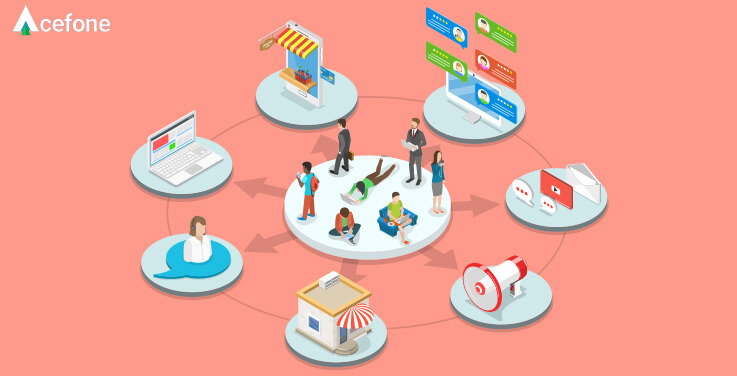UCaaS or Unified Communications as a Service, has emerged as a best-in-class solution that improves communication and collaboration within businesses, thereby optimising processes, driving revenue, and building strong customer relationships.
The solution offers immense convenience; thus, businesses are proactively adopting the technology to be able to stay ahead of their competitors.
So, what exactly is UCaaS?
UCaaS refers to a cloud delivery model, capable of bringing the entire communication and collaboration network of an organisation onto a single platform, thus ‘unifying’ them in the process.
It integrates multiple channels to improve both, the internal and external, collaboration and communication of an organisation. A typical UC solution comprises:
- Call control
- Digital telephony
- Messaging apps including emails, chat, voice mail, SMS
- Video conferencing
- Document sharing
- Mobility tools
- Management portal
Constant evolution has been the mantra for businesses in the 21st century and UCaaS has witnessed the same growth and change. There are several upcoming technologies that can be integrated with UCaaS and significantly change the way workplaces utilise the solution.
Two such technologies are Augmented Reality (AR) and 5G Technology.
Let’s understand them in detail:
AR: Augmented Reality
Despite the giant leaps in communications technologies, modern devices aren’t able to replicate the experience of a face-to-face conversation. IP-assisted video calls do enable long-distance conversations with the single click of a button, but they still fail to capture the nuances of a real-time conversation.
Virtual or augmented reality are emerging technologies that can solve this problem.
Both technologies exist at the cusp of real and virtual worlds, allowing users to interact with virtual renditions in real-time. Many of us would have seen these devices being actively used in the gaming industry, worn by video gamers playing an adventurous game.
We can soon expect the rapid diversification of AR for training, simulation, and collaboration purposes, more specifically, as a way to offer new modes of communication through UCaaS.
Virtual Reality, like the name suggests, creates a digital reality that can be accessed through special headsets. Users can interact with digital constructs within the environment and their head motions can be judged to detect and render the notion of looking around within the environment.
Augmented Reality creates an overlay of interactive graphics and information over real-world objects. Pokemon Go is one of the most popular examples of Augmented Reality, where various in-game elements, including Pokemons, were overlaid over the surroundings when seen through the device.
Here are some ways Augmented Reality can benefit your business through the existing UCaaS systems:
-
Real-time communication
AR-powered devices can be used to place 2D objects on any surface or even hang 3D holograms in space. Now, you can converse through a hologram of either your teammate or your customer instead of communicating through voice or video calls. A live and holographic image of your CEO delivering the annual town hall speech can be beamed to multiple locations worldwide, thus, cutting down travel expenses and increasing employee engagement.
Integrating conversational channels such as chatbots, virtual assistants, and video-assisted support with AR can add another dimension to UCaaS solutions.
Contact centers can heavily leverage these technologies to provide better customer support. Confusing instruction manuals or complicated processes can be replaced by simple instructions overlaid step-by-step on the screen such that they can guide the customer through the process.
-
Improved collaboration
AR and VR introduce new ways of working and collaboration for businesses, even in remote working conditions. The COVID-19 pandemic-induced global lockdown disrupted the traditional way of working worldwide.
During these uncertain times, UCaaS emerged as a one-stop solution to implement and promote remote working through collaborative tools such as VoIP-backed video conferencing tools.
Through AR and VR, employees can simply strap on their headsets or engage with other AR-powered devices, and enter a collaborative, interactive environment. New product designs, infrastructural blueprints, or technical faults can be projected in meeting rooms, thus providing an accurate view of how various designs and plans will materialise in the real world.
Similarly, operational glitches in real-world environments (such as faulty valves at oil rigs) can be recreated via AR, and the digital projections can be studied by off-site engineers who can then provide point-accurate guidance to on-site colleagues for necessary repairs and maintenance.
-
Informative visualisation
Business teams, whether they are dealing with internal or external matters, require ready access to data visualisation and analysis tools to derive actionable insights from operational data.
While UCaaS enables systematic capturing and analysis of data, AR integration can create useful data simulations for employees. Such solutions can be made interactive to show instant results as per input.
This aspect of AR can also be extended to company presentations wherein data figures or product designs can be demonstrated through 3D holograms, instead of 2D histograms or flow designs.
Businesses can also utilise this solution in the form of realistic tours or guided product demos to give clients a life-like experience of the finished product.
5G Technology
5G technology has been around for more than a decade now and while it is yet to penetrate globally, it is being put to use by multiple carriers for public and commercial usage in several countries.
Boasting of higher speeds and lower latency, 5G technology is bound to replace 4G telephony solutions and is expected to enable several new-age technologies such as autonomous cars, and smart homes.
So, what exactly does 5G technology offer?
First of all, 5G is expected to be up to 100 times faster than 4G connections, allowing higher upload and download speeds. This means that you can also stream 8K and 3D videos on your smartphone.
Furthermore, it will considerably reduce network latency between devices and servers. With negligible latency, devices can be configured to make split-second decisions, such as autonomous cars deciding to brake in a split second to avoid road accidents.
5G technology offers several benefits over existing telecom solutions and it can impact UCaaS in far-reaching ways. Some major areas wherein 5G is expected to create a big splash in terms of UCaaS solutions are:
-
Ease of remote collaboration
The pandemic gave rise to the new WFH or work from home trend in the modern business environment. Employees worked from the comfort of their homes and collaborated through cloud-hosted solutions such as video conferencing and digital whiteboarding tools.
5G technology can significantly improve the quality of these tools by making them smoother and quicker. Seamless communication between team members, devoid of network congestions, can lead to uninterrupted workflow and execution, thus, contributing to maximised operational efficiency and success.
-
Reliability on better quality
The lower latency and higher speed offered by 5G networks make it highly reliable for essential business operations such as customer support. You do not want to irk your customers by engaging with them through glitchy Internet connections. Smoother and synchronous communication between customers and support staff can be enabled via 5G networks.
Interactive experiences for customers can also be reliably hosted on 5G cloud networks through faster connections. The technology can enable the development of new tools and platforms for effective communication and engagement with customers.
Both AR and 5G are still in the nascent stages and only time will tell how companies adopt and integrate these solutions with their existing UCaaS infrastructure. However, the advantages of adopting AR and 5G technologies and integrating both with UCaaS make them an offer that is too good to refuse.
To know more about this, get on-call with our cloud experts at 1888-859-0450 or drop an email at [email protected]














